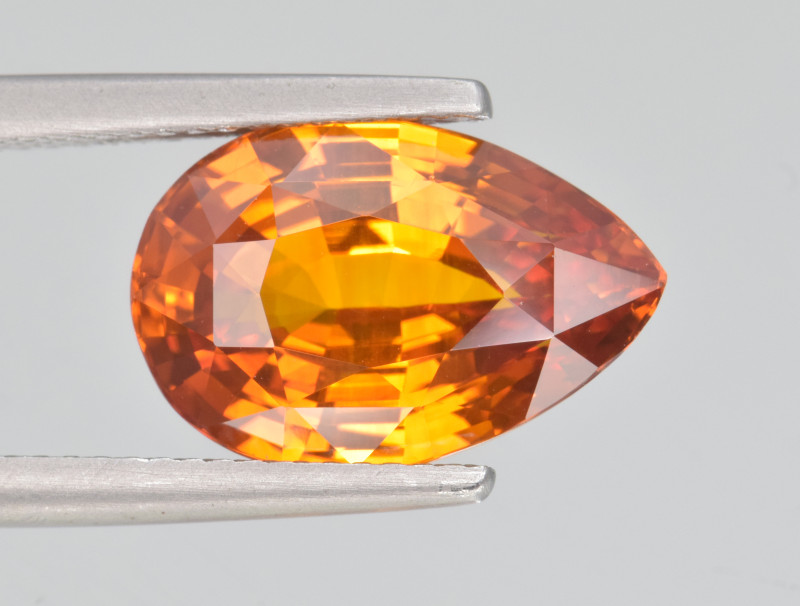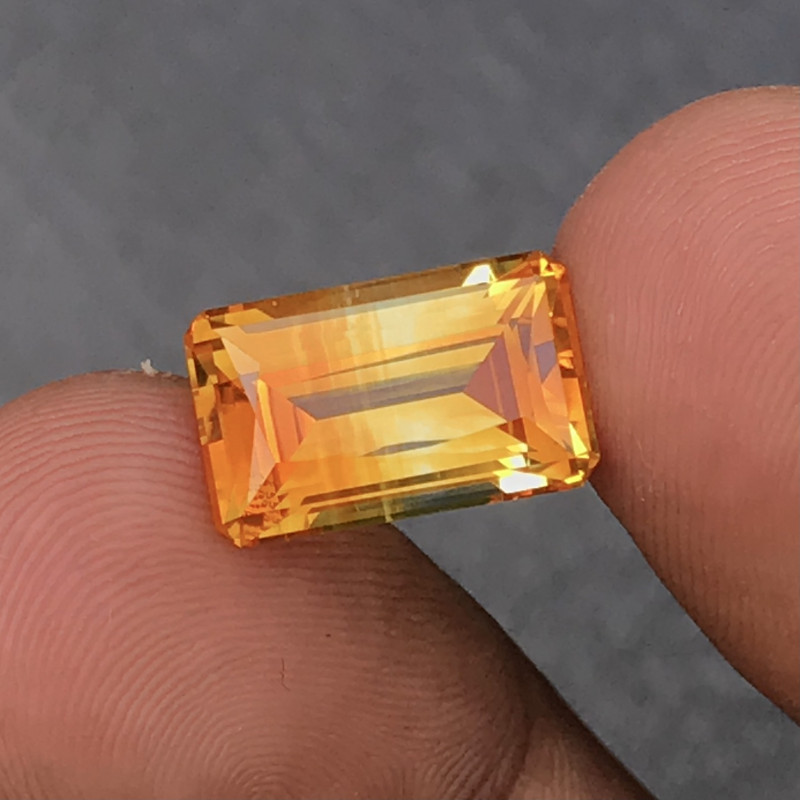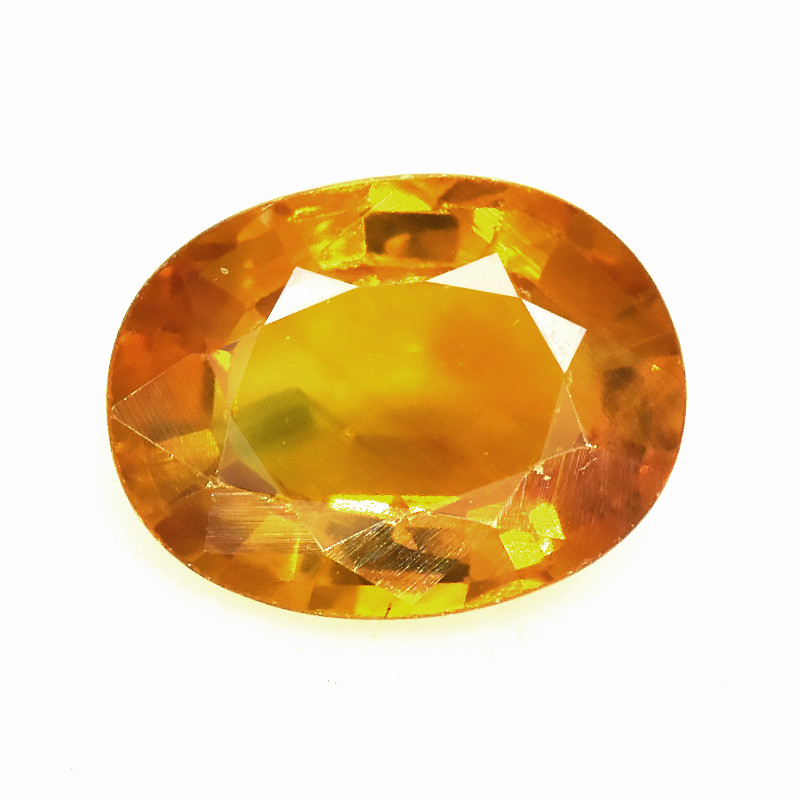
Orange Sapphire Gemstone: Nneɛma, Nkyerɛase, Botae & Nea Ɛkeka Ho
 Safir a ɛyɛ borɔdɔma yɛ kɔla a wonnim pii wɔ aboɔden abo a wɔfrɛ no safir ho. Nanso so safir a ɛyɛ borɔdɔma yɛ nokware? Yiw, abo yi fi awosu mu na ɛba, ɛwom sɛ pii a wɔtɔn wɔ gua so no yɛ nea wɔde nneɛma ayɛ anaasɛ wɔayɛ ho adwuma de.
Safir a ɛyɛ borɔdɔma yɛ kɔla a wonnim pii wɔ aboɔden abo a wɔfrɛ no safir ho. Nanso so safir a ɛyɛ borɔdɔma yɛ nokware? Yiw, abo yi fi awosu mu na ɛba, ɛwom sɛ pii a wɔtɔn wɔ gua so no yɛ nea wɔde nneɛma ayɛ anaasɛ wɔayɛ ho adwuma de.
So safir a ɛyɛ borɔdɔma ho yɛ na? Yiw, abɔde mu safir a ɛyɛ borɔdɔma a wɔansiesie no ho yɛ na, na ɛyɛ nea wubehu sɛ wɔretɔn no mu bɛyɛ ɔha biara mu nkyem 0.001 pɛ.
Dɛn na wɔfrɛ safir a ɛyɛ borɔdɔma? Ebia ebinom bɛkyekyɛ Padparadscha safir mu wɔ saa kuw yi mu, nanso nsonsonoe a ɛda nsow wɔ hɔ a yɛbɛka ho asɛm.
Ɛwom sɛ safir a ɛyɛ borɔdɔma ho yɛ na de, nanso borɔdɔma nyɛ safir kɔla a ɛho yɛ na sen biara. Dɛn ne safir kɔla a wɔntaa nhu? Safir kɔla a wɔntaa nhu ne Kashmir safir bruu a ɛte sɛ velvet, ɛwom sɛ Padparadscha safir yɛ nea ɛto so abien a ɛbɛn de.
Woasiesie wo ho sɛ wubehu pii? Kɔka yɛn ho bere a yɛrebubu orange sapphire agyapade, mfaso horow, ne bo, abakɔsɛm, ne nea ɛkeka ho no!

Ɛfa Orange Sapphire Stone ho
Orange sapphire yɛ aboɔden abo a ɛsom bo ne “kɔla a ɛyɛ fɛ” safir, efisɛ ɛnyɛ bruu.
Safir nyinaa yɛ September awo abo . November nkokoaa nso betumi adi afahyɛ, efisɛ safir a ɛyɛ borɔdɔma boa citrine , November awobo a wɔde di dwuma wɔ amanne kwan so no pɛpɛɛpɛ.
Safir yɛ ayeforohyia afe a ɛto so 5, 45, ne 75 a wɔde di dwuma wɔ amanne kwan so aboɔden abo ne nsoromma mu hwɛ abo a wɔde yɛ sɛnkyerɛnne Taurus.
Orange Sapphire Nkyerɛkyerɛmu & Su ahorow
Sɛ́ corundum bi no, safir a ɛyɛ borɔdɔma yɛ aluminium oxide aboɔden abo. Ruby ne safir ne corundum ahorow abien no.
Mpɛn pii no, aboɔden abo no yɛ ahwehwɛ a ɛte sɛ toa, a ɛyɛ tratraa a ɛyɛ prismatic, anaa bipyramidal. Ebetumi nso ayɛ abotan nketenkete, akɛse, anaa abotan a wɔabobɔw.
Safir a ɛyɛ borɔdɔma a nneɛma bi ka ho (diaspore anaa rutile akuwakuw a ɛne ne ho di nsɛ) betumi ada nsoromma mu hwɛ adi, ade a wɔde hwɛ ade a ɛma hann a ɛte sɛ nsoromma ba. Eyinom yɛ “nsoromma safir” a ɛyɛ borɔdɔma.
Nneɛma a aka a ɛwɔ safir a ɛyɛ borɔdɔma mu ne:
Mohs a ɛyɛ den : 9
Kɔla : Nneɛma a ɛyɛ borɔdɔma a ɛyɛ kɔkɔɔ, kɔkɔɔ, anaa bruu a ɛwɔ ase ka ho
Ahwehwɛ nhyehyɛe : Ahinanan (afã abiɛsa) .
Luster : Adamantine kosi vitreous (ahwehwɛ) .
Transparency : Ɛyɛ nea ɛda adi pefee kosi nea ɛnyɛ nea ɛda adi pefee
Nneɛma a ɛma nneɛma yɛ mmerɛw : 1.76-1.77
Nnipa dodow : 3.98-4.10
Cleavage : Biara nni hɔ
Akisikuru : Conchoidal
Streak : Ɛyɛ fitaa
Luminescence : Fluorescence & X-ray kɔla ahorow a ɛwɔ hɔ; Orange-red a ano yɛ den wɔ LW-UV (abɔde mu); Orange a ɛyɛ mmerɛw yiye kosi kɔkɔɔ wɔ SW-UV (synthetic) mu; X-ray kɔla ahorow a ɛwɔ nhwɛsode ahorow bi a efi Sri Lanka, Kashmir, ne Montana - kɔkɔɔ a ɛyɛ kusuu anaa kɔkɔɔ-akutu
Pleochroism : Ɛwɔ hɔ & ɛyɛ den yiye wɔ yellow-brown kosi orange/colorless mu
Nsonsonoe abien : 0.008-0.009
Optical effects : Ɛtɔ mmere bi a asterism
Ntrɛwmu : 0.018
 Mfonini a ɛwɔ atifi hɔ no: Padparadscha safir
Mfonini a ɛwɔ atifi hɔ no: Padparadscha safir
Orange Safir ne Padparadscha Safir
Ebinom bu safir a ɛyɛ borɔdɔma sɛ Padparadscha safir , nanso ɛsono abien no.
Padparadscha safir yɛ safir a ɛho yɛ na a ɛyɛ nwonwa a wɔde Sinhalese asɛmfua padmaraṃga , a ɛkyerɛ “lotus-kɔla” din too so Saa Afrika aboɔden abo yi wɔ baabi a ɛda pink ne borɔdɔma ntam, nanso ne kɔla pɔtee no yɛ nea wogye ho akyinnye kɛse .
Nsɛmfua ahorow a wɔde kyerɛkyerɛ Padparadscha safir kɔla mu bi ne:
Owigya
Owia apuei
Aprɛko a wɔde yɛ nneɛma
Piikyi
Saamɔn
Gemological Institute of America (GIA) ka sɛ ɛsɛ sɛ Padparadscha safir nya nne a ɛyɛ hare kosi mfinimfini a ɛyɛ borɔdɔma-pink kosi pinkish-orange, a enni ase yɛ bruu. Ɛsɛ sɛ wɔkyekyɛ kɔla no nso pɛpɛɛpɛ a kɔla biara nni hɔ.
Sɛnea GIA nhwehwɛmu bi kyerɛ no, Atɔe Famfo aboɔden abo ho animdefo ka sɛ ɛsɛ sɛ Padparadscha safir yɛ pastel. Nhwehwɛmu koro no ara daa no adi sɛ adetɔfo pii de safir a ɛyɛ pink bataa nea ɛwɔ ase a ɛyɛ kɔkɔɔ ho nanso Padparadscha safir ne nea ɛwɔ ase a ɛyɛ borɔdɔma.
Yenim ampa sɛ kɔla no fi dade ne chromium mu, na chromium a ɛkɔ soro no kyerɛ kɔla a ɛyɛ pinker.
Sɛ yɛbɛbɔ no mua a : Padparadscha safir yɛ soronko wɔ safir a ɛyɛ borɔdɔma ho wɔ sɛnea ɛwɔ pink -orange kɔla mu, na aboɔden abo ho animdefo pii ka sɛ Padparadscha safir yɛ pastel, bere a safir a ɛyɛ borɔdɔma betumi ayɛ nea ɛyɛ hyew.
Sɛ yɛkata saa nsonsonoe no so a, yɛbɛkɔ orange sapphire sɛnkyerɛnne kwan so.

Orange Sapphire Nkyerɛase & Abakɔsɛm
Safir a ɛyɛ borɔdɔma yɛ nhyɛso, anigye, ne anidaso ho sɛnkyerɛnne. Saa abo yi yɛ agyan ma adebɔfo, sɛ́ ɛyɛ nnwontofo, akyerɛwfo, adwumfo, anaa afoforo. Wɔsan nso ka sɛ wɔma nyansa ma gyinaesi na wɔhyɛ tumidi ho nkuran.
Abakɔsɛm
Asɛmfua “safire” no wɔ ntini abien a ebetumi aba sɛ efi ase. Biako ne Tete Hela sappheiros , a ɛkyerɛ “ɔbo bruu,” a ɛfa “safire” a ɛka lapis lazuli ne aboɔden abo afoforo a ɛyɛ bruu ho asɛm kosii Mfinimfini Mmere no mu.
Mfiase foforo a ebetumi aba ne Sanskrit kasa mu śanipriya , a ɛkyerɛ “kronkron ma Saturn,” a ɛfa fekubɔ a safir ne Saturn nya wɔ Hindufo nsoromma mu hwɛ mu ho.
Nkɔso titiriw biako a ɛkɔɔ so wɔ akutu safir abakɔsɛm mu sii wɔ afe 2001 mu, bere a Australiani aboɔden abo ho ɔbenfo Terry Coldham bɔɔ aduru foforo bi a wɔfrɛ no beryllium diffusion a wɔde sa akutu safir ho amanneɛ no.
Coldham bɔɔ amanneɛ sɛ dade ho ɔbenfo bi a ɔwɔ Thailand yɛɛ ɔkwan bi a wɔfa so di Tanzania safir ho dwuma ma ɛyɛ borɔdɔma a ɛhyerɛn kosi kɔkɔɔ-akutu, na ɛde abodin ahorow te sɛ “Sunset sapphire” bae.
Asɛm no bae bere a na nea wɔfrɛ no Padparadscha safir pii a wɔakyerɛw so sɛ “ɛyɛ hyew” nkutoo refi Thailand reba no mu. Eduu afe 2002 no, aboɔden abo ho adwumayɛbea ahorow a agye din hui sɛ wɔde beryllium atrɛw akɔ aboɔden abo no mu bere a wɔreyɛ hyew no.
Wɔ afe 2003 mu no, Chanthaburi Aboɔden abo ne Aguade Fekuw no yɛɛ ho biribi denam mmara a wɔhyɛe sɛ ɛsɛ sɛ wɔn a wɔtɔn no da ayaresa pɔtee no adi no so.
Ɛnnɛ, saa safir a ɛyɛ borɔdɔma a beryllium apete so yi da so ara wɔ baabiara.

Orange Sapphire Ayaresa Nneɛma
Wobetumi de safir a ɛyɛ borɔdɔma adi dwuma sɛ abo a wɔde sa yare . Sɛ́ aboɔden abo a ɛyɛ borɔdɔma , saa ahwehwɛ yi betumi ama adebɔ, ahotoso, ne charisma atu mpɔn.
Afei nso, orange sapphires yɛ sacral chakra abo akɛse , ɛkari pɛ wɔ ahoɔden mfinimfini ma ɛkari pɛ ba wo nkate mu na ɛma wunya asetra mu anigye koraa.
Nipadua mu Ayaresa
Wɔ honam fam no, wɔka sɛ safir a ɛyɛ borɔdɔma sa anaa ɛma ɛyɛ yiye:
Awo a wɔde ma
Ahoɔden
Ɔbarima ne ɔbea nna ho akɔnnɔ
Gland nhyehyɛe
Mogya mu haw ahorow
Nkate mu Ayaresa
Safir ɔbo a ɛyɛ borɔdɔma no so ba obiara a ɔhwehwɛ sɛ ɔbɛda ne ho adi kɛse wɔ adebɔ mu. Wɔkyerɛ sɛ ahwehwɛ a owia bɔ no ma ɛyɛ hyew na ɛma awerɛhyem.
Bio nso, safir a ɛyɛ borɔdɔma betumi ama w’adwene atu mpɔn denam dadwen a ebeyi afi hɔ na ahyɛ wo nkuran sɛ di wo nkate akyi no so.
Sɛ́ aboɔden abo no, so safir a ɛyɛ borɔdɔma som bo? Ɛno gyina ne su so.

Orange Sapphire Aboɔden abo Nneɛma a Ɛwɔ Hɔ
Orange sapphire bo gyina ne kɔla, ne twitwa, nea emu da hɔ, carat mu duru, ayaresa, ne abɔde vs. synthetic adebɔ so.
Ahosuo
Safir kɔla ahorow a ɛyɛ borɔdɔma fi pastel a ɛyɛ mmerɛw so kosi mogya borɔdɔma a ɛyɛ hyew so, a mpɛn pii no ɛyɛ kɔkɔɔ anaa bruu wɔ ase. Safir a ɛyɛ borɔdɔma a wɔntaa nhu na ɛsom bo sen biara (a ɛwɔ Padparadscha akyi) no wɔ borɔdɔma a ɛyɛ hyew fi awosu mu a enni nnyigyei a ɛwɔ ase.
Wɔ abɔde mu no, ebia kɔla no fi chromium ne dade efĩ anaasɛ abɔde mu mframa a wɔde hyɛ mu mu.
Twa
Mpɛn pii no, safir a ɛyɛ borɔdɔma wɔ afã horow , a ɛkame ayɛ sɛ ɛwɔ nsusuwii biara a ebetumi aba. Nneɛma a ɛyɛ kurukuruwa anaa nea ɛhyerɛn abu so. Nneɛma a wɔatwa no sɛnea wɔpɛ no som bo yiye, nanso ɛsɛ sɛ nea wɔatwa no nyinaa yɛ nea ɛne ne ho hyia na ɛyɛ pɛpɛɛpɛ.
Ɛsɛ sɛ wotwitwa nsoromma a ɛyɛ borɔdɔma safir sɛ cabochons na ama wɔada wɔn aniwa so tumi adi.
Ɛda adi pefee
Sapphires wɔ Type II kɔla aboɔden abo a emu da hɔ grade , a ɛkyerɛ sɛ wɔhwɛ kwan sɛ wɔde nneɛma nketenkete bi a wotumi hu bɛka ho.
Nneɛma a wɔtaa de ka ho no bi ne:
Hexagonal kɔla banding anaasɛ onyin nkyerɛwde
Nsateaa nkyerɛwee
Zircon ahwehwɛ, a mpɛn pii no “halo” a ɛpaapae a ɛyɛ sum
Ahwehwɛ ahorow (sɛ nhwɛso no, garnet , hematite , corundum, spinel) .
Nneɛma a wɔde ka ho a wotumi hu kɛse kyerɛ sɛ ɛsom bo a ɛba fam na mpɛn pii no ɛyɛ mmerɛw sɛ ɛbɛkyɛ.
Nea yɛaka yi nyinaa akyi no, abɔde mu safir a ɛyɛ borɔdɔma ho yɛ na araa ma nea wɔde nka ho kakraa bi kosi nea ɛkɔ fam mpo som bo yiye.
Carat Mu duru
Abɔde mu safir a ɛyɛ borɔdɔma a ne kɛse yɛ kɛse ho yɛ na, titiriw nea ɛwɔ kɔla pa a efi awosu mu. Enti, aboɔden abo akɛse wɔ bo a ɛkɔ soro wɔ carat biara ho.
Ayaresa ahorow
Ɔhyew a wɔde sa yare (a ɛma kɔla ne/anaasɛ nea emu da hɔ tu mpɔn) yɛ nea ɛfata ma safir. Ɛkame ayɛ sɛ wɔama safir a ɛyɛ borɔdɔma biara a ɛwɔ hɔ no ayɛ hyew, enti hwɛ hu sɛ wubebisa aboɔden abo ho nhwehwɛmubea amanneɛbɔ a agye din.
Nea ɛntaa nsi nanso ɛda so ara abu so ne beryllium diffusion , a ɛno nso de ɔhyew di dwuma na ɛtew nne bruu so. Saa ayaresa yi betumi adan safir a ɛyɛ ahabammono a ɛyɛ kusuu anaasɛ ɛyɛ kɔkɔɔ akosi safir a ɛyɛ borɔdɔma anaa kɔkɔɔ a ɛyɛ hyew. Beryllium a ɛtrɛw nso betumi ama Padparadscha kɔla ahorow aba.
Kɔla foforo a wɔde sa yare ne irradiation , a ebetumi ama safir a enni kɔla ayɛ borɔdɔma, nanso aboɔden abo a wɔde mframa a ano yɛ den ahyɛ mu no nyɛ nea wɔpɛ kɛse.
Wɔ nsoromma safir a ɛyɛ borɔdɔma fam no, wɔtaa de ɔhyew a wɔde yɛ adwuma na ama kɔla ne nea emu da hɔ atu mpɔn, bere a wobetumi ayɛ diffusion ayaresa de ama “nsoromma” no atu mpɔn.
Kwati safir a ɛyɛ borɔdɔma a abubu anaasɛ abura ahyɛ mu ma.
Nneɛma a wɔde yɛ nneɛma
Ɛkame ayɛ sɛ safir a wɔde yɛ borɔdɔma abu so te sɛ nea wɔayɛ ho adwuma no, efisɛ abɔde mu nneɛma no ho yɛ na yiye. Akwan a wɔtaa fa so yɛ ne flux anaa ogyaframa fusion akwan. Saa akwan horow yi yɛ nea mfomso biara nni ho kɛse, ɛnyɛ nea ɛho nhia wɔ sikasɛm mu, na ɛtra hɔ daa.
Ebinom bu nneɛma a wɔde yɛ nneɛma no sɛ “atoro” safir, nanso ɛwɔ honam fam ne nnuru su te sɛ wɔn mfɛfo abɔde mu de no.
Wobɛyɛ dɛn ahu sɛ safir a ɛyɛ borɔdɔma yɛ “nokware” anaasɛ nea wɔayɛ? Ɔkwan a ɛyɛ nokware sen biara ne sɛ wɔbɛma obi a ɔyɛ aboɔden abo ho ɔbenfo asɔ ahwɛ. Nanso wɔ afiri a wɔde hwɛ nneɛma nketenkete ase no, nneɛma bi a ɛkyerɛ sɛ:
Bubbles a ɛyɛ hu
Flux a wɔde ka ho
Ntrɛwmu a ɛyɛ kurukuruwa
Saa nneɛma a wɔde yɛ nneɛma yi nso mu da hɔ a mfomso biara nni ho sen abɔde mu abo.
Sɛ yɛreka abɔde mu abo ho asɛm a, ɔkwan bɛn so na safir a ɛyɛ borɔdɔma yɛ?

Orange Sapphire Formation & Nneɛma a Wɔde Yɛ Adwuma
Corundum abo te sɛ safir a ɛyɛ borɔdɔma no yɛ abotan a ɛyɛ metamorphic anaa igneous mu.
Wɔ abotan a ogya wom mu no, ɔbo no yɛ ahwehwɛ bere a ɔbotan no dwo fi magma mu no. Mmere a ɛma onwini kyɛ no ma ahwehwɛ akɛse ba. Ɛsɛ sɛ ɔbotan a ɛyɛ ogya no yɛ nea aluminium pii wom na silica nni mu, te sɛ nepheline syenites.
Wɔ abotan a ɛsakra mu no, ahwehwɛ no ba bere a tete po ase dan fi nsu a ɛyɛ hyew a aluminium pii wom mu no.
Mpɛn pii no, abotan a ɛkura safir no sɛe, na ɛma nsu tumi de aboɔden abo no kɔ nsu a ɛtɔ te sɛ nsubɔnten mu.
Kɔla a ɛyɛ borɔdɔma no ba bere a chromium efĩ ne ɛlɛtrɔnik a ɛyera bom (“ɛlektrɔn tokuru.”) Kɔla a wɔkyekyɛ no ba bere a chromophores ahorow gye mmeae ahorow wɔ ɔbo no mu no.
Mmeae a Wɔtu Tuo
Ɛnnɛ, Australia ne Madagascar na wonya safir a ɛyɛ borɔdɔma sen biara. Sri Lanka ne Tanzania nso yɛ nea ɛho hia.
Titiriw no, ɛtɔ mmere bi a wɔtɔn safir a ɛyɛ borɔdɔma a efi Umba Bon mu, Tanzania, sɛ Padparadscha safir, ɛwom sɛ ɛyɛ tuntum na ɛyɛ bruu sen sɛnea aboɔden abo ho animdefo dodow no ara betumi akyerɛ sɛ ɛyɛ Padparadscha de.
Wɔtaa de ɔhyew yɛ safir a efi mmeae ahorow wɔ Tanzania, Vietnam, ne Madagascar ma ɛyɛ “akutu-nsu” anaa “papaya” kɔla ahorow a ɛyɛ fɛ.

Orange Sapphire Bo & Ne Bo
Ɛnyɛ bere nyinaa na safir a ɛyɛ borɔdɔma bo yɛ mmerɛw, nanso ne bo yɛ den sen Padparadscha safir a ebetumi adu dɔla 30,000 wɔ carat biako mu no.
Orange sapphire abo a wɔayɛ ne nea wɔayɛ ho adwuma bo sua koraa sen abɔde mu nneɛma, mpɛn pii no ɛba fam $8-$10 wɔ carat biara mu.
Aboɔden abo a ɛyɛ borɔdɔma a ɛnyɛ den no nyinaa fi $450-$10,000 wɔ carat biara mu. Nneɛma bo a ɛkɔ soro no yɛ abo akɛse a emu da hɔ na ne kɔla yiye.
Safire a ɛyɛ hare a ɛyɛ borɔdɔma-kɔla kosi kɔkɔɔ-akutu bo a ɛwɔ carat biako mu no fi $50-$750 wɔ carat biara a ɛba fam sen carat 2 ne $375-$1,625 wɔ carat biara a ɛboro carat 2 so.
Nsoromma a ɛyɛ borɔdɔma safir nya $100-$300 wɔ carat biara mu bere a ɛyɛ 0.5-1 carat ne $100-$500 wɔ carat biara mu bere a ɛyɛ 1-5 carat.
Orange Sapphire Hwɛ ne Nsiesiei
Nea etwa to no, yɛbɛka aboɔden abo a wɔhwɛ so ho asɛm . Orange sapphires yɛ super durable, kɛse ma da biara da hyɛ. Nanso, ebia wobɛpɛ sɛ wode nhyehyɛe ahorow a ɛbɔ wo ho ban ma safir mpɛtea a ɛyɛ borɔdɔma.
Nanso, safir a ɛyɛ borɔdɔma a abɔde mu mframa de kɔla ayɛ no betumi ayera esiane awia hann anaa ɔhyew nti bere kɔ so no, enti ma ɛno ntra w’adwenem.
Fa brɔs a ɛyɛ mmerɛw a wɔde di dwuma daa, samina a ɛnyɛ den, ne nsu a ɛyɛ hyew hohoro safir a ɛyɛ borɔdɔma ho.

Fa Orange Sapphire gye Anidaso Tom!
Ebia bruu ne kɔla a nnipa dodow no ara ani gye ho, nanso borɔdɔma ka asɛm bi ampa. Safir a ɛyɛ borɔdɔma ka anigye ne adwempa bom a ɛbɛma wo mu hyerɛn ada adi wɔ nna a ɛyɛ sum mpo mu!
搜尋Gemstone Encyclopedia
相關拍賣
相關文章
Momma yɛnkyerɛkyerɛ sɛnea wɔtɔ aboɔden abo wɔ intanɛt so. Yɛwɔ aboɔden aboɔ a ɛso sen biara wɔ intanɛt so na ɛbɛtumi ayɛ den kakra wɔ mfitiaseɛ no. Ma yɛmfa afotu bi a mfaso wɔ so mmoa wo.
3rd Oct 2018
W’aboɔden abo a wobɛhwɛ so no boa ma ɛyɛ fɛ wɔ wo nkwa nna nyinaa mu. Yɛbɛka nneɛma te sɛ denden ne ayaresa ho asɛm, ne anammɔn a ɛfa sɛnea wobɛhohoro wo aboɔden abo na wode asie dwoodwoo ho.
9th May 2018
So woasusuw sɛnea wɔyɛ Ruby aboɔden abo ho pɛn? Ayaresa ahorow pii wɔ gua so na yɛbɛboa ma yɛakyerɛkyerɛ mu
9th May 2018
最新的文章
Nnua a wɔde asonse a wɔasen a wɔsan frɛ no nhabannuru asonse no yɛ abɔde mu ade a wɔde si asono asonse ananmu, na wotwa fi Amerika Kesee Fam phytelephas nnuadewa mu nnuadewa mu wɔ abrabɔ pa mu. Sua mmɛw asonse ho ade nyinaa wɔ akwankyerɛ yi mu!
15th Jan 2026
Chrysanthemum nhwiren abo yɛ abɔde mu anwonwade a ɛwɔ calcite, celestite, anaa andalusite nhwiren fitaa bi a wɔde asisi limestone tuntum anaa atɛkyɛ abo so.
13th Jan 2026
Rainbow lattice sunstone yɛ feldspar ahorow a ɛwɔ optical nsunsuanso abiɛsa fɛfɛ a efi nneɛma ahorow a wɔde ka ho a ɛwɔ hɔ no mu ba. Ɛyɛ ogya kɔla display ne lattice nsusuwso ma ɛyɛ coletor abohene a wɔntaa nhu!
12th Jan 2026
文章類別
How To's is where you will find helpful articles from gem Rock Auctions on how to cut gemstones, select gemstones and buy gemstones.
9文章





